Beko RDNE350K20X, RDNE350K20XB, RDNE350K30XBN User manual [EN,ES,FR,IT]

Refrigerator
User Manual
Refrigerador
Manual del usuari
Réfrigérateur
Manuel d’utilisation
Frigorifero
Manuale utente
RDNE350K20X-RDNE350K20XB-RDNE350K30XBN
EN/ ES/ FR/İT
57 9941 0000/AJ 1/4 EN-ES-FR-İT

Please read this user manual first!
Dear Customer,
We hope that your product, which has been produced in modern plants and checked under the most meticulous quality control procedures, will provide you an effective service.
Therefore, read this entire user manual carefully before using the product and keep it as a reference. If you handover the product to someone else, give the user manual as well.
The user manual will help you use the product in a fast and safe way. t Read the manual before installing and operating the product.
t Make sure you read the safety instructions.
t Keep the manual in an easily accessible place as you may need it later. t Read the other documents given with the product.
Remember that this user manual is also applicable for several other models. Differences between models will be identified in the manual.
Explanation of symbols
Throughout this user manual the following symbols are used:
CImportant information or useful tips.
AWarning against dangerous conditions for life and property. BWarning against electric voltage.
C INFORMATION |
.The model information as stored in the product data |
base |
|
|
|
||
|
|
can be reached by entering following website and searching |
|
|
|
for your model identifier (*) found on energy label. |
|
SUPPLIER’S NAME |
MODEL IDENTIFIER |
(*) |
|
A |
A |
https://eprel.ec.europa.eu/ |
|
|
|
|
|

CONTENTS |
|
|
1 Your Refrigerator |
3 |
|
2 |
Safety and Environment |
|
Instructions |
4 |
|
General Safety ................................... |
4 |
|
Intended Use ..................................... |
7 |
|
Child Safety ....................................... |
7 |
|
Compliance with WEEE Directive and |
||
Disposing of the Waste Product......... |
7 |
|
Compliance with RoHS Directive ....... |
7 |
|
Package Information.......................... |
7 |
|
Recommendations for the fresh food |
||
compartment..................................... |
8 |
|
3 |
Installation |
9 |
Points to be paid attention to when the |
||
relocation of the refrigerator ............... |
9 |
|
Electrical connection........................ |
10 |
|
Disposing of the packaging ............. |
10 |
|
Disposing of your old refrigerator ..... |
10 |
|
Placing and Installation .................... |
10 |
|
Changing the illumination lamp ....... |
11 |
|
Adjusting the legs ............................ |
11 |
|
4 Preparation |
12 |
|
5 Using your refrigerator 14 |
|
Temperature setting button .............. |
14 |
Setting the temperature of your |
|
refrigerator ....................................... |
14 |
Dual cooling system ........................ |
14 |
Vacation Function ............................ |
14 |
Freezing fresh food .......................... |
15 |
Recommendations for preservation of |
|
frozen food ...................................... |
15 |
Placing the food .............................. |
15 |
Stopping your product..................... |
16 |
Deep-freeze information .................. |
16 |
Chill compartment ........................... |
17 |
Making ice ....................................... |
17 |
Rotary storage container ................. |
18 |
Icematic and ice storage container |
.. 18 |
Description and cleaning of odor |
|
filter ................................................ |
19 |
Reversing the doors ........................ |
20 |
Reversing the doors ........................ |
21 |
6 Maintenance and |
|
cleaning |
22 |
Protection of plastic surfaces .......... |
22 |
7 Troubleshooting |
23 |
2 EN
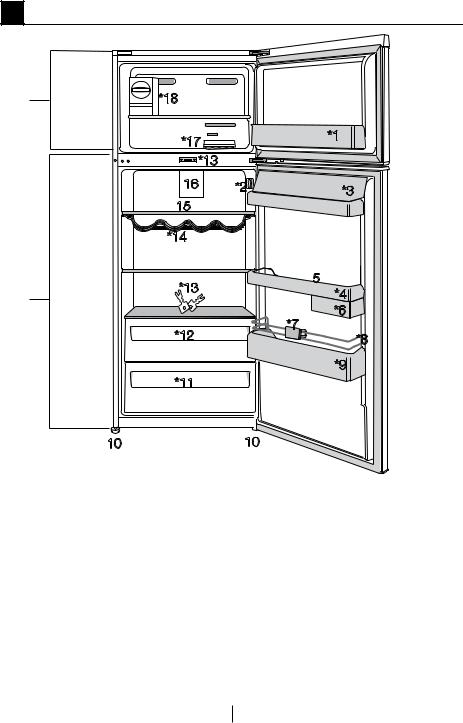
1 Your Refrigerator
19
20
*18 |
|
|
*17 |
|
*1 |
|
|
|
*13 |
|
|
16 |
*2 |
*3 |
15 |
|
|
*14 |
|
|
*13 |
|
5 |
|
*4 |
|
|
|
|
|
|
*6 |
*12 |
|
*7 |
|
*8 |
*9
*11
10
1.Freezer compartment door shelf
2.Temperature setting button
3.Butter & Cheese sections
4.Fridge compartment door shelf
5.Egg holders
6.Rotary storage container
7.Bottle holder
8.Shelter wire
9.Bottle shelf
10.Adjustable legs
11.Crisper
Figures that take place in this instruction manual are schematic and may not correspond exactly with your product. If the subject parts are not included in the product you have purchased, then it is valid for other models.
3 EN

|
Safety and Environment Instructions |
|||||||
2 |
||||||||
|
|
|
|
|
|
|
|
|
This |
section provides the |
|
|
|
|
|
||
|
|
|
WARNING: |
|
||||
safety instructions necessary |
|
|
|
Do not store explosive |
|
|||
to prevent the risk of injury and |
|
A |
|
substances such as |
|
|||
material damage. Failure to |
|
|
aerosol cans with a |
|
||||
|
|
|
|
|||||
observe these instructions will |
|
|
|
flammable propellant in |
|
|||
invalidate all types of product |
|
|
|
this appliance. |
|
|||
warranty. |
|
|
|
|
|
|
||
Intended use |
This appliance is intended to be |
|||||||
|
WARNING: |
used in household and similar |
||||||
|
Keep ventilation |
applications such as |
||||||
A |
openings, in the |
– staff kitchen areas in shops, |
||||||
appliance enclosure or |
offices and other working |
|||||||
|
||||||||
|
in the built-instructure, |
environments; |
||||||
|
clear of obstruction. |
– farm houses and by clients in |
||||||
|
WARNING: |
hotels, motels and other residential |
||||||
|
Do not use mechanical |
type environments; |
||||||
|
devices or other |
– bed and breakfast type |
||||||
A |
means to accelerate |
environments; |
||||||
the defrostingprocess, |
– catering and similar non-retail |
|||||||
|
||||||||
|
other than those |
applications. |
||||||
|
recommended by the |
General Safety |
||||||
|
manufacturer. |
t This product should not be used by |
||||||
|
|
|
|
persons with physical, sensory and |
||||
|
WARNING: |
|
|
|||||
A |
|
|
mental disabilities, without sufficient |
|||||
Do not damage the |
|
|
knowledge and experience or by |
|||||
|
refrigerant circuit. |
|
|
|||||
|
|
|
|
children. The device can only be used |
||||
|
WARNING: |
|
|
|||||
|
|
|
by such persons under supervision |
|||||
|
Do not use electrical |
|
|
and instruction of a person responsible |
||||
|
appliances inside |
|
|
for their safety. Children should not be |
||||
|
the food storage |
|
|
allowed to play with this device. |
||||
A |
compartments of the |
t In case of malfunction, unplug the |
||||||
|
|
device. |
||||||
|
appliance, unless |
|
|
|||||
|
t After unplugging, wait at least 5 minutes |
|||||||
|
they are of the type |
|
|
before plugging in again. |
||||
|
recommended by the |
t Unplug the product when not in use. |
||||||
|
manufacturer. |
t Do not touch the plug with wet hands! |
||||||
|
|
|
|
Do not pull the cable to plug off, always |
||||
|
|
|
|
|||||
|
|
|
|
hold the plug. |
||||
4 EN

t Do not plug in the refrigerator if the socket is loose.
t Unplug the product during installation, maintenance, cleaning and repair.
t If the product will not be used for a while, unplug the product and remove any food inside.
t Do not use the product when the compartment with circuit cards located on the upper back part of the product (electrical card box cover) (1) is open.
1
1 |
t Do not use steam or steamed cleaning materials for cleaning the refrigerator and melting the ice inside. Steam may contact the electrified areas and cause short circuit or electric shock!
t Do not wash the product by spraying or pouring water on it! Danger of electric shock!
t In case of malfunction, do not use the product, as it may cause electric
shock. Contact the authorized service before doing anything.
t Plug the product into an earthed socket. Earthing must be done by a qualified electrician.
t If the product has LED type lighting, contact the authorized service for replacing or in case of any problem.
t Do not touch frozen food with wet hands! It may adhere to your hands!
t Do not place liquids in bottles and cans into the freezer compartment. They may burst out!
t Place liquids in upright position after tightly closing the lid.
t Do not spray flammable substances near the product, as it may burn or explode.
t Do not keep flammable materials and products with flammable gas (sprays, etc.) in the refrigerator.
t Do not place containers holding liquids on top of the product. Splashing water on an electrified part may cause electric shock and risk of fire.
t Exposing the product to rain, snow, sunlight and wind will cause electrical danger. When relocating the product, do not pull by holding the door handle. The handle may come off.
t Take care to avoid trapping any part of your hands or body in any of the moving parts inside the product.
t Do not step or lean on the door, drawers and similar parts of the refrigerator. This will cause the product to fall down and cause damage to the parts.
t Take care not to trap the power cable.
5 EN

t When positioning the appliance, ensure the supply cord is not trapped or damaged.
t Do not locate multiple portable socket-outlets or portable power supplies at the rear of the appliance.
t Children aged from 3 to 8 years are allowed to load and unload refrigerating appliances.
t To avoid contamination of food, please respect the following instructions:
t – Opening the door for long periods can cause a significant increase of the temperature in the compartments of the appliance.
t – Clean regularly surfaces that can come in contact with food and accessible drainage systems.
t – Clean water tanks if they have not been used for 48 h; flush the water system connected to a water supply if water has not been drawn for 5 days.
t – Store raw meat and fish in suitable containers in the refrigerator, so that it is not in contact with or drip onto other food.
t – Two-star frozen-food compartments are suitable for storing pre-frozen food, storing or making icecream and making ice cubes.
t – One-, twoand three-star compartments are not suitable for the freezing of fresh food.
t – If the refrigerating appliance is left empty for long periods, switch off, defrost, clean, dry, and leave the door open to prevent mould developing within the appliance.
1.1.1 HC Warning
If the product comprises a cooling system using R600a gas, take care to avoid damaging the cooling system and its pipe while using and moving the product. This gas is flammable. If the cooling system is damaged, keep the product away from sources of fire and ventilate the room immediately.
The label on the inner left
Cside indicates the type of gas used in the product.
1.1.2 For Models with Water Dispenser
t Pressure for cold water inlet shall be maximum 90 psi (6.2 bar). If your water pressure exceeds 80 psi (5.5 bar), use a pressure limiting valve in your mains system. If you do not know how to check your
water pressure, ask for the help of a professional plumber.
t If there is risk of water hammer effect in your installation, always use a water hammer prevention equipment in your installation. Consult Professional plumbers if you are not sure that there is no water hammer effect in your installation.
t Do not install on the hot water inlet. Take precautions against of the risk of freezing of the hoses. Water temperature operating interval shall
be 33°F (0.6°C) minimum and 100°F (38°C) maximum.
t Use drinking water only.
6 EN

Intended Use
t This product is designed for home use. It is not intended for commercial use.
t The product should be used to store food and beverages only.
t Do not keep sensitive products requiring controlled temperatures (vaccines, heat sensitive medication, medical supplies, etc.) in the refrigerator.
t The manufacturer assumes no responsibility for any damage due to misuse or mishandling.
t Original spare parts will be provided for 10 years, following the product
purchasing date.
Child Safety
t Keep packaging materials out of children’s reach.
t Do not allow the children to play with the product.
t If the product’s door comprises a lock, keep the key out of children’s reach.
Compliance with WEEE Directive and Disposing of
the Waste Product
This product complies with EU WEEE Directive (2012/19/EU). This product bears a classification symbol for waste electrical and electronic equipment (WEEE).
This product has been
manufactured with high quality parts and materials which can be reused and are suitable for
recycling. Do not dispose of the waste product with normal domestic and other wastes at the end of its service life. Take it to the
collection center for the recycling of electrical and electronic equipment. Please consult your local authorities to learn about these collection centers.
Compliance with RoHS
Directive
• This product complies with EU WEEE Directive (2011/65/EU).
It does not contain harmful and prohibited materials specified in the Directive.
Package Information
Packaging materials of the product are manufactured from recyclable materials in accordance with our National Environment Regulations. Do not dispose of the packaging materials together with the domestic or other wastes. Take them to the packaging material collection points designated by the local authorities.
7 EN

Recommendations for the fresh food compartment
*May not be available in all models
Do not allow the food to touch the temperature sensor in fresh food compartment. To allow the fresh food compartment keep its ideal storage temperature, sensor must not be hindered by food.
Do not place hot foods in the product.
MILK |
|
|
juice |
temperature |
|
etc. |
||
sensor |
||
|
8 EN
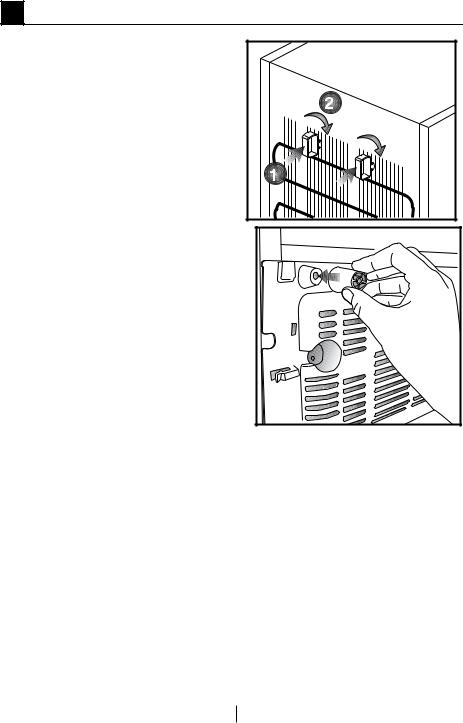
3 Installation
B In case the information which are given in the user manual are not taken into account, manufacturer will
not assume any liability for this.
Points to be paid attention to when the relocation of the refrigerator
1.Your refrigerator should be unplugged.Before transportation of your refrigerator, it should be emptied and cleaned.
2.Before it is re-packaged, shelves, accessories, crisper, etc. inside your refrigerator should be fixed with adhesive tape and secured against impacts. Package should
be bound with a thick tape or sound ropes and the transportation rules on the package should be strictly observed.
3.Original packaging and foam materials should be kept for future transportations or moving.
Before you start the refrigerator,
Check the following before you start to use your refrigerator:
1. Attach 2 plastic wedges as illustrated below. Plastic wedges are intended to keep the distance which will ensure the air circulation between your refrigerator and the wall. (The picture is drawn up as a representation and it is not identical with your product.)
9
2.Clean the interior of the refrigerator as recommended in the “Maintenance and cleaning” section.
3.Connect the plug of the refrigerator to the wall socket. When the fridge door is opened, fridge internal lamp will turn on.
4.When the compressor starts to operate, a sound will be heard. The liquid and gases sealed within the refrigeration system may also give rise to noise, even if the compressor is not running and this is quite normal.
5.Front edges of the refrigerator may feel warm. This is normal. These areas are designed to be warm to avoid condensation.
EN

Electrical connection
Connect your product to a grounded socket which is being protected by a fuse with the appropriate capacity.
Important:
The connection must be in compliance with national regulations.
t The power plug must be easily accessible after installation.
t Electrical safety of your refrigerator shall be guaranteed only if the earth system in your house complies with standards.
t The voltage stated on the label located at left inner side of your product should be equal to your network voltage.
t Extension cables and multi plugs must not be used for connection.
B A damaged power cable must be replaced by a qualified electrician.
B Product must not be operated before it is repaired! There is the risk of electric
shock!
Disposing of the packaging
The packing materials may be dangerous for children. Keep the packing materials out of the reach of children or dispose of them by
classifying them in accordance with the waste instructions stated by your local authorities. Do not throw away with regular house waste, throw away on packaging pick up spots designated by the local authorities.
The packing of your refrigerator is produced from recyclable materials.
Disposing of your old refrigerator
Dispose of your old refrigerator without giving any harm to the environment.
t You may consult your authorized dealer or waste collection center of your municipality about the disposal of your refrigerator.
Before disposing of your refrigerator, cut out the electric plug and, if there are any locks on the door, make them inoperable in order to protect children against any danger.
Placing and Installation
A If the entrance door of the room where the refrigerator will be installed is not wide enough for the refrigerator to pass through, then call the authorized service to have them remove the
doors of your refrigerator and pass it sideways through the door.
1.Install your refrigerator to a place that allows ease of use.
2.Keep your refrigerator away from heat sources, humid places and direct sunlight.
3.Do not place your product on the materials such as rug or carpet.
4.Place your refrigerator on an even floor surface to prevent jolts.
5.Your product requires adequate air circulation to function efficiently. If the product will be placed in an alcove, remember to leave at least 5 cm clearance between the product and the ceiling, rear wall and the side walls.
6.If the product will be placed in an alcove, remember to leave at least 5 cm clearance between the product and the ceiling, rear wall and the side walls. Check if the rear wall clearance protection component is present at its location (if provided with the product). If the component is not available, or if it is lost or fallen, position the product so that at least 5 cm clearance shall be left between the rear surface of the product and the wall of the room. The clearance at the rear is important for efficient operation of the product.
10 EN
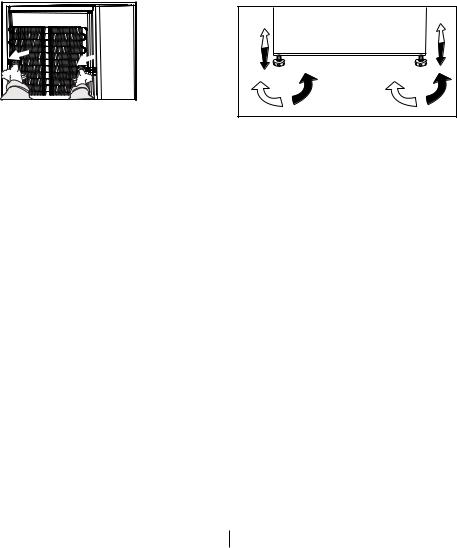
t The condenser of your appliance is located on the back as shown below. In order to achieve better energy efficiency with lower energy consumption, please pull the condenser towards yourself as illustrated in picture below. The
condenser position will be fixed firmly by means of locking mechanisim of the top holders on each side.
* OPTIONAL
v |
Changing the illumination lamp
To change the Bulb/LED used for illumination of your refrigerator, call your AuthorisedService.
The lamp(s) used in this appliance is not suitable for household room
illumination. The intended purpose of this lamp is to assist the user to place foodstuffs in the refrigerator/freezer
in a safe and comfortable way.The lamps used in this appliance have to withstand extreme physical conditions such as temperatures below -20 °C.
(only chest and upright freezer)
Adjusting the legs
If your refrigerator is unbalanced;
You can balance your refrigerator by turning its front legs as illustrated in the figure. The corner where the leg exists is lowered when you turn in the direction of black arrow and
raised when you turn in the opposite direction. Taking help from someone to slightly lift the refrigerator will facilitate this process.
11 EN

4 |
Preparation |
|
t |
For a freestanding appliance; ‘this |
ambient temperature falls to -15 |
refrigerating appliance is not intended |
°C, frozen food in the freezer does |
|
to be used as a built-in appliance’. |
not thaw thanks to its Advanced |
|
t Your cooler/freezer should be |
Electronic Temperature Control |
|
installed at least 30 cm away from |
System. For the first installation, the |
|
heat sources such as hobs, ovens, |
product should NOT be placed under |
|
central heater and stoves and at least |
low ambient temperatures. This is |
|
5 cm away from electrical ovens and |
because the freezer cannot go down |
|
should not be located under direct |
to standard operation temperature. |
|
sunlight. |
When reaching continuous operation, |
|
t Please make sure that the interior |
the product can be moved to |
|
of your cooler/freezer is cleaned |
another place. Thus, later you can |
|
thoroughly. |
place your product in the garage |
|
t If two coolers are to be installed side |
or an unheated room without the |
|
by side, there should be at least 2 cm |
concern of causing frozen food to |
|
distance between them. |
get rotten. However, it is likely that |
|
t When you operate your cooler/freezer |
above mentioned low temperatures |
|
for the first time, please observe the |
may cause the freezing of the food in |
|
following instructions during the initial |
the fridge compartment; thus, please |
|
six hours. |
consume the food items in the fridge |
|
t Its door should not be opened |
in a controlled way as needed. When |
|
frequently. |
ambient temperature goes back |
|
t It must be operated empty without |
to normal, you may change button |
|
placing any food in it. |
setting according to your need. |
|
t Do not unplug your cooler/freezer. |
t If the ambient temperature is below |
|
If a power failure occurs out of your |
0°C, the food in fridge compartment |
|
control, please see the warnings in |
will freeze. Therefore, we recommend |
|
the “Recommended solutions for the |
not using the fridge compartment |
|
problems” section. |
in such low ambient temperatures. |
|
t The baskets/drawers that are |
You may continue to use the freezer |
|
provided with the chill compartment |
compartment as usual. |
|
must always be in use for low energy |
t In some models, the instrument panel |
|
consumption and for better storage |
automatically turns off 5 minutes |
|
conditions. |
after the door has closed. It will |
|
t Food contact with the temperature |
be reactivated when the door has |
|
sensor in the freezer compartment |
opened or pressed on any key. |
|
may increase energy consumption of |
|
|
the appliance. Thus any contact with |
|
|
the sensor(s) must be avoided. |
|
|
t This product has been designed to |
|
|
function at ambient temperatures |
|
|
up to 43 °C (90 SDgrF). Even if the |
|
|
12 EN

t Due to temperature change as a result of opening/closing the product door during operation, condensation on the door/body shelves and the glass containers is normal.
t Since hot and humid air will not directly penetrate into your product when the doors are not opened, your product will optimize itself in conditions sufficient to protect your food. Functions and components such as compressor, fan, heater, defrost, lighting, display and so on will operate according to the needs to consume minimum energy under these circumstances.
t In case of multiple options are present glass shelves must be placed so that the air outlets at the backwall are not blocked, prefably air outlets are remaining below the glass shelf. This combination may help impoving air distribution and energy efficiency.
13 EN
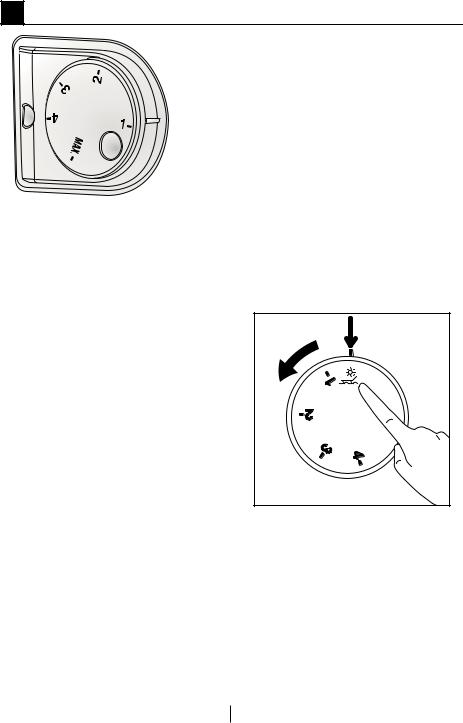
5 Using your refrigerator
Temperature setting button
Temperature setting button allows you to make the temperature setting of your refrigerator.
Setting the temperature of your refrigerator
The overall temperature setting of your refrigerator is made by means of the temperature setting button on the right wall of the fridge compartment.
This button has 5 different temperature setting position. Select the position suitable to your needs.
Dual cooling system
Your refrigerator is equipped with two separate cooling systems to cool the fresh food compartment and freezer compartment. Thus, air in the fresh food compartment and freezer compartment do not get mixed.
Thanks to these two separate cooling systems, cooling speed is much higher then other refrigerators. Odours in the compartments do not get mixed. Also additional power saving is provided since the automatic defrosting is performed individually.
Vacation Function
If the doors of the product are not opened for 12 hours after the
thermostat is switched to the hottest position, then the vacation function will be activated automatically.
Open the door of the product or change the thermostat setting to cancel the function.
Vacation function is optional. It may vary depending on the product type and may not be contained in every product.
It is not recommended to store food in cooler compartment when the vacation function is active.
14 EN

Freezing fresh food
t It must be preferred to wrap or cover the food before placing them in the refrigerator.
t Hot food must cool down to the room temperature before putting them in the refrigerator.
t The foodstuff that you want to freeze must be fresh and in good quality.
t Foodstuff must be divided into portions according to the family’s daily or meal based consumption needs.
t The foodstuff must be packaged in an airtight manner to prevent them from drying even if they are going to be kept for a short time.
t Materials to be used for packaging must be tear-proof and resistant to cold, humidity, odor, oils and acids and they must also be airtight.
Moreover, they must be well closed and they must be made from easy- to-use materials that are suitable for deep freeze usage.
t Frozen food must be used immediately after they are thawed and they should never be re-frozen.
t Please observe the following instructions to obtain the best results.
1.Do not freeze too large quantities of food at one time. The quality of the food is best preserved when it is frozen right through to the core as quickly as possible.
2.Placing warm food into the freezer compartment causes the cooling system to operate continuously until the food is frozen solid.
3.Take special care not to mix already frozen food and fresh food.
Recommendations for preservation of frozen food
t Prepacked commercially frozen food should be stored in accordance
with the frozen food manufacturer's instructions for a  ( 4 star) frozen food storage compartment.
( 4 star) frozen food storage compartment.
t To ensure that the high quality achieved by the frozen food manufacturer and the food retailer is maintained, the following should be remembered:
1.Put packages in the freezer as quickly as possible after purchase.
2.Ensure that contents are labeled and dated.
3.Do not exceed "Use By", "Best Before" dates on the packaging.
Defrosting
The freezer compartment defrosts automatically.
Placing the food
Freezer |
Various frozen food |
|
such as meat, |
||
compartment |
||
fish, ice cream, |
||
shelves |
||
vegetables and etc. |
||
|
||
|
|
|
Egg tray |
Egg |
|
|
|
|
Fridge |
Food in pans, |
|
compartment |
covered plates and |
|
shelves |
closed containers |
|
|
|
|
Fridge |
Small and packaged |
|
food or drinks (such |
||
compartment |
||
as milk, fruit juice and |
||
door shelves |
||
beer) |
||
|
||
|
|
|
Crisper |
Vegetables and fruits |
|
|
|
15 EN

|
|
Delicatessen |
|
Freshzone |
products (cheese, |
|
compartment |
butter, salami and |
|
|
etc.) |
Deep-freeze information |
||
Food must be frozen as rapidly as possible when they are put in a refrigerator in order to keep them in good quality.
It is possible to keep the food for a long time only at -18°C or lower temperatures.
You can keep the freshness of food for many months (at -18°C or lower temperatures in the deep freeze).
WARNING! A
t Foodstuff must be divided into portions according to the family’s daily or meal based consumption needs.
t Foodstuff must be packaged in an airtight manner to prevent them from drying even if they are going to be kept for a short time.
t Materials necessary for packaging: t Cold resistant adhesive tape
t Self adhesive label t Rubber rings
t Pen
Materials to be used for packaging the foodstuff must be tear-proof and resistant to cold, humidity, odor, oils and acids.
Foodstuff to be frozen should not be allowed to come in contact with the previously frozen items to prevent their partial thawing.
Frozen food must be used immediately after they are thawed and they should never be re-frozen.
Stopping your product
If your thermostat is equipped with “0” position:
- Your product will stop operating when you turn the thermostat button to “0” (zero) position. Your product will not start unless to you turn the thermostat button to position “1” or one of the other positions again.
If your thermostat is equipped with “min” position:
- Unplug your product to stop it.
16 EN
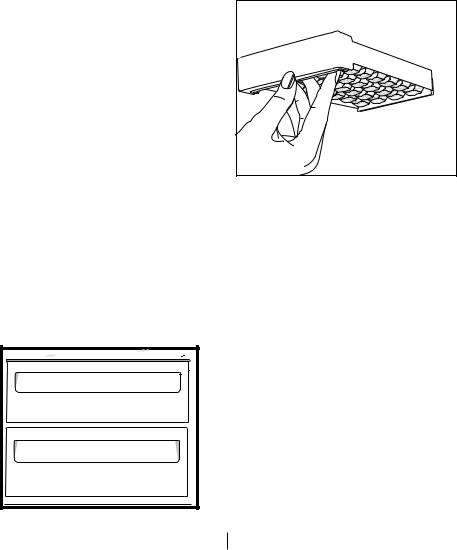
Chill compartment
Chill compartment is ideal for storing solid dairy products meat, fish and poultry. Chill compartment temperature remains between -2°C and +3°C, slightly colder than freshfood compartment.
Prior to placing in the freezing compartment for storage, it is advised that you place such foodstuffs in chill compartment first for energy saving and better storage performance. If chill compartment is full, you may
use freshfood compartment for this purpose.
It is not recommended to store vegetables and fruits in chill compartment.
The chill compartment drawer is optional to use. The appliance fulfills the chill compartment temperature storage requirements with and without the drawer provided.
You can increase the inner volume of your refrigerator by removing the drawer of chill compartment. Pull the drawer towards yourself until it is stopped by the stopper. Raise the
front part for approximately 1 cm and pull the compartment towards yourself again to remove it completely.
Making ice
*optional
Fill the ice container with water and place it into the freezer compartment. Your ice will be ready approximately in two hours.
You can remove the ice in the ice container by removing it from the freezer and twisting it.
17 EN
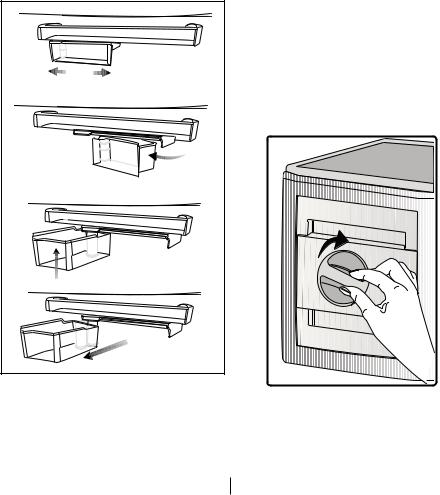
Rotary storage container
(in some models)
Sliding body shelf can be moved to left or right in order to allow you place the tall bottles, jars or boxes to the lower shelf (Fig. 1)
You can reach the food that you have placed into the shelf by grabbing and turning it from its right edge (Fig.2).
When you want to load or remove it to clean, turn it by 90 degrees, raise it up and pull towards yourself (Fig. 3-4).
1 |
2 |
3 |
4 |
18 |
Icematic and ice storage container
*May not be available in all models Using the Icematic
Fill the Icematic with water and place it into its seat. Your ice will be ready approximately in two hours. Do not
remove the Icematic from its seating to take ice.
Turn the knobs on the ice reservoirs clockwise by 90 degrees.
Ice cubes in the reservoirs will fall down into the ice storage container below.
You may take out the ice storage container and serve the ice cubes.
If you wish, you may keep the ice cubes in the ice storage container.
Ice storage container
Ice storage container is only intended for accumulating the ice cubes. Do not put water in it. Otherwise, it will break.
EN

Description and cleaning of odor filter
*May not be available in all models
Odor filter prevents unpleasant odor build-up in your refrigerator.
Pull the cover into which the odor filter is installed downwards from the front section and remove as illustrated. Leave the filter under sunlight for one day. Filter will be cleaned during this time. Install the filter back to its place.
Odor filter must be cleaned once in a year.
19 EN
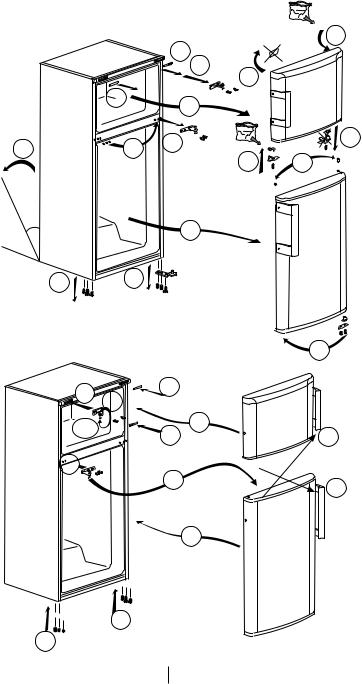
Reversing the doors
Proceed in numerical order .
4 5
4 2
7 |
6 |
1 |
|
 10
10
10
|
11 |
12 |
13 |
45°
3
8 9
|
|
14 |
|
18 |
19 |
|
|
17 |
|
||
180° |
19 |
22 |
|
24 |
|||
|
|||
23 |
21 |
|
|
|
24 |
||
|
|
||
|
|
20 |
 16 15
16 15 

20 EN

Reversing the doors
Proceed in numerical order .
 11
11
7 |
|
6 1
 1
1
 1
1
60°
|
|
|
1
1 1
1 0°
1
0
1
17 



16
21 EN

6 Maintenance and cleaning
A Never use gasoline, benzene or similar substances for cleaning purposes.
B We recommend that you unplug the appliance before cleaning.
B Never use any sharp abrasive instrument, soap, household cleaner, detergent and wax polish for cleaning.
B For non-No Frost products, water drops and frosting up to a
fingerbreadth occur on the rear wall of the Fridge compartment. Do not clean it; never apply oil or similar agents on it.
B Only use slightly damp microfiber cloths to clean the outer surface of the product. Sponges and other types of cleaning cloths may scratch the surface.
CUse lukewarm water to clean the cabinet of your refrigerator and wipe it dry.
CUse a damp cloth wrung out in a solution of one teaspoon of
bicarbonate of soda to one pint of water to clean the interior and wipe it dry.
B Make sure that no water enters the lamp housing and other electrical items.
B If your refrigerator is not going to be used for a long period of time, unplug the power cable, remove all food, clean it and leave the door ajar.
CCheck door seals regularly to ensure they are clean and free from food particles.
A To remove door racks, remove all the contents and then simply push the door rack upwards from the base.
A Never use cleaning agents or water that contain chlorine to clean the outer surfaces and chromium coated parts of the product. Chlorine causes corrosion on such metal surfaces.
A Do not use sharp, abrasive tools, soap, household cleaning agents, detergents, kerosene, fuel oil, varnish etc. to prevent removal and deformation of the prints on the plastic part. Use lukewarm water and a soft cloth for cleaning and then
wipe it dry.
Protection of plastic surfaces
CDo not put the liquid oils or oil-cooked meals in your refrigerator in unsealed containers as they damage the plastic surfaces of your refrigerator. In case of spilling or smearing oil on the plastic surfaces, clean and rinse the relevant part of the surface at once with warm water.
22 EN
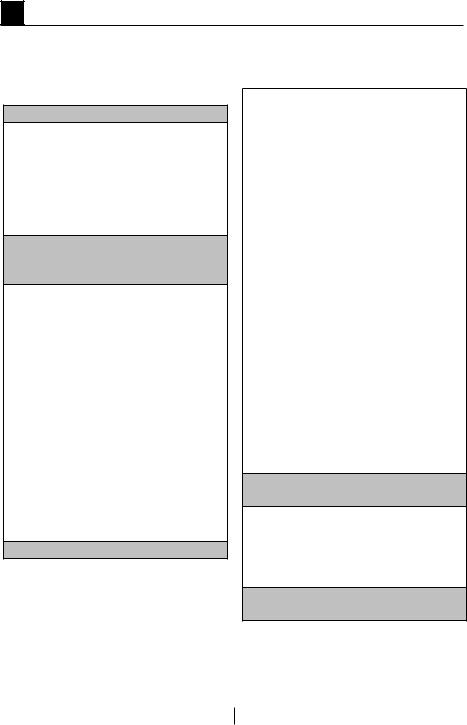
7 Troubleshooting
Please review this list before calling the service. It will save your time and money. This list includes frequent complaints that are not arising from defective workmanship or material usage. Some of the features described here may not exist in your product.
The refrigerator does not operate.
t The plug is not inserted into the socket correctly. >>>Insert the plug into the socket securely.
t The fuse of the socket which your refrigerator is connected to or the main fuse have blown out.
>>>Check the fuse.
Condensation on the side wall of the fridge compartment (MULTIZONE, COOL CONTROL and FLEXI ZONE).
t Door has been opened frequently.
>>>Do not open and close the door of refrigerator frequently.
t Ambient is very humid. >>>Do not install your refrigerator into highly humid places.
t Food containing liquid is stored in open containers. >>>Do not store food with liquid content in open containers.
t Door of the refrigerator is left ajar. >>>Close the door of the refrigerator.
t Thermostat is set to a very cold level. >>>Set the thermostat to a suitable level.
t Compressor is not running
t Protective thermic of the compressor will blow out during sudden power failures or plugout plug-ins as the refrigerant pressure in the cooling system of the refrigerator has not been balanced yet. The refrigerator will
start running approximately after 6 minutes. Please call the service if the refrigerator does not startup at the end of this period.
t The fridge is in defrost cycle.
>>>This is normal for a fullautomatically defrosting refrigerator. Defrosting cycle occurs periodically.
t The refrigerator is not plugged into the socket. >>>Make sure that the plug is fit into the socket.
t Temperature settings are not made correctly. >>>Select the suitable temperature value.
t There is a power outage.
>>>Refrigerator returns to normal operation when the power restores.
The operation noise increases when the refrigerator is running.
t The operating performance of the refrigerator may change due to the changes in the ambient
temperature. It is normal and not a fault.
The refrigerator is running frequently or for a long time.
23 EN

t New product may be wider than the previous one. Larger refrigerators operate for a longer period of time.
t The room temperature may be high.
>>>It is normal that the product operates for longer periods in hot ambient.
t The refrigerator might be plugged in recently or might be loaded with food. >>>When the refrigerator
is plugged in or loaded with food recently, it will take longer for it to attain the set temperature. This is normal.
t Large amounts of hot food might be put in the refrigerator recently.
>>>Do not put hot food into the refrigerator.
t Doors might be opened frequently or left ajar for a long time. >>>The
warm air that has entered into the refrigerator causes the refrigerator to run for longer periods. Do not open the doors frequently.
t Freezer or fridge compartment door might be left ajar. >>>Check if the doors are closed completely.
t The refrigerator is adjusted to a very low temperature. >>>Adjust
the refrigerator temperature to a warmer degree and wait until the temperature is achieved.
t Door seal of the fridge or freezer may be soiled, worn out, broken or not properly seated. >>>Clean or replace the seal. Damaged/broken seal causes the refrigerator to run for a longer period of time in order to maintain the current temperature.
Freezer temperature is very low while the fridge temperature is sufficient.
t The freezer temperature is adjusted to a very low value. >>>Adjust the freezer temperature to a warmer degree and check.
Fridge temperature is very low while the freezer temperature is sufficient.
t The fridge temperature is adjusted to a very low value. >>>Adjust the fridge temperature to a warmer degree and check.
Food kept in the fridge compartment drawers is frozen.
t The fridge temperature is adjusted to a very high value. >>>Adjust the fridge temperature to a lower value and check.
Temperature in the fridge or freezer is very high.
t The fridge temperature is adjusted to a very high value. >>>Fridge
compartment temperature setting has an effect on the temperature of the freezer. Change the temperatures of the fridge or freezer and wait until the relevant compartments attain a sufficient temperature.
t Doors are opened frequently or left ajar for a long time. >>>Do not open the doors frequently.
t Door is ajar. >>>Close the door completely.
t The refrigerator is plugged in or loaded with food recently. >>>This
is normal. When the refrigerator is plugged in or loaded with food recently, it will take longer for it to attain the set temperature.
t Large amounts of hot food might be put in the refrigerator recently.
>>>Do not put hot food into the refrigerator.
24 EN
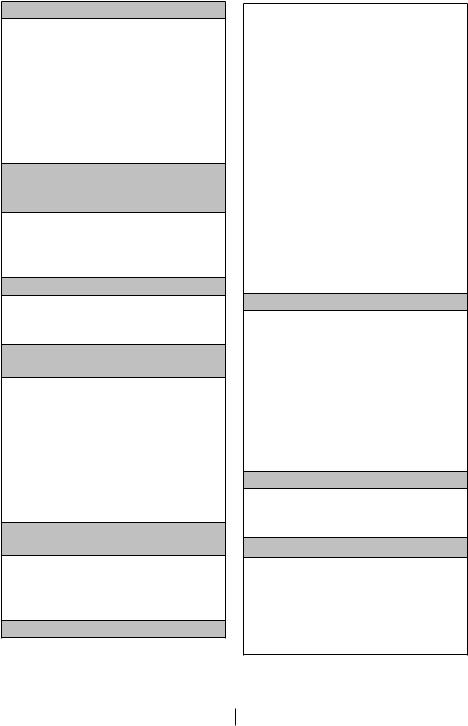
t Vibrations or noise.
t The floor is not level or stable. >>>
If the refrigerator rocks when moved slowly, balance it by adjusting
its feet. Also make sure that the floor is strong enough to carry the refrigerator, and level.
t The items put onto the refrigerator may cause noise. >>>Remove the items on top of the refrigerator.
There are noises coming from the refrigerator like liquid flowing, spraying, etc.
t Liquid and gas flows occur in accordance with the operating principles of your refrigerator. It is normal and not a fault.
Whistle comes from the refrigerator.
t Fans are used in order to cool the refrigerator. It is normal and not a fault.
Condensation on the inner walls of refrigerator.
t Hot and humid weather increases icing and condensation. It is normal and not a fault.
t Doors are opened frequently or left ajar for a long time. >>>Do not open the doors frequently. Close them if they are open.
t Door is ajar. >>>Close the door completely.
Humidity occurs on the outside of the refrigerator or between the doors.
t There might be humidity in the air; this is quite normal in humid
weather. When the humidity is less, condensation will disappear.
Bad odour inside the refrigerator.
t No regular cleaning is performed.
>>>Clean the inside of the refrigerator regularly with a sponge, lukewarm water or carbonate dissolved in water.
t Some containers or package materials may cause the smell.
>>>Use a different container or different brand packaging material.
t Food is put into the refrigerator in uncovered containers. >>>Keep
the food in closed containers. Microorganisms spreading out from uncovered containers can cause unpleasant odours.
t Remove the foods that have expired best before dates and spoiled from the refrigerator.
The door is not closing.
t Food packages are preventing the door from closing. >>>Replace the packages that are obstructing the door.
t The refrigerator is not completely even on the floor. >>>Adjust the feet to balance the refrigerator.
t The floor is not level or strong.
>>>Make sure that the floor is level and capable to carry the refrigerator.
Crispers are stuck.
t The food is touching the ceiling of the drawer. >>>Rearrange food in the drawer.
If The Surface Of The Product Is Hot.
t High temperatures may be observed between the two doors, on the side panels and at the rear grill while the product is operating. This is normal and does not require service maintenance!
25 EN
DISCLAIMER / WARNING
Some (simple) failures can be adequately handled by the end-user without any safety issue or unsafe use arising, provided that they are carried out within the limits and in accordance with the following instructions (see the “Self-Repair” section).
Therefore, unless otherwise authorized in the “Self-Repair” section below, repairs shall be addressed to registered professional repairers in order to avoid safety issues. A registered professional repairer is a professional repairer that has been granted access to the instructions and spare parts list of this product by the manufacturer according to the methods described in legislative acts pursuant to Directive 2009/125/EC.
However, only the service agent (i.e. authorized professional repairers) that you can reach through the phone number given in the user manual/warranty card or through your authorized dealer may provide service under the guarantee terms. Therefore, please be advised that repairs by professional repairers (who are not authorized by Beko) shall void the guarantee. Self-Repair
Self-repair can be done by the end-user with regard to the following spare parts: door handles,door hinges, trays, baskets and door gaskets (an updated list is also available in support.beko.com as of 1st March 2021).
Moreover, to ensure product safety and to prevent risk of serious injury, the mentioned self-repair shall be done following the instructions in the user manual for self-repair or which are available in support.beko.com. For your safety, unplug the product before attempting any self-repair.
Repair and repair attempts by end-users for parts not included in such list and/ or not following the instructions in the user manuals for self-repair or which are available in support.beko.com, might give raise to safety issues not attributable to Beko, and will void the warranty of the product.
Therefore, it is highly recommended that end-users refrain from the attempt to carry out repairs falling outside the mentioned list of spare parts, contacting in such cases authorized professional repairers or registered professional repairers. On the contrary, such attempts by end-users may cause safety issues and damage the
product and subsequently cause fire, flood, electrocution and serious personal injury to occur.
By way of example, but not limited to, the following repairs must be addressed to authorized professional repairers or registered professional repairers: compressor, cooling circuit, main board,inverter board, display board, etc.
The manufacturer/seller cannot be held liable in any case where end-users do not comply with the above.
The spare part availability of the refrigerator that you purchased is 10 years.
During this period, original spare parts will be available to operate the refrigerator properly
The minimum duration of guarantee of the refrigerator that you purchased is 24 months.

Lea este manual antes de utilizar el frigorífico.
Estimado cliente:
Esperamos que este producto, que ha sido fabricado en plantas dotadas de la más avanzada tecnología y sometido a los más estrictos procedimientos de control de calidad, le preste un servicio eficaz.
Para ello, le recomendamos que lea atentamente el presente manual antes de utilizar el producto, y que lo tenga a mano para futuras consultas.
Este manual
t Le ayudará a usar el electrodoméstico de manera rápida y segura.
t Lea el manual antes de instalar y poner en funcionamiento el producto. t Siga las instrucciones, en particular las relacionadas con la seguridad.
t Conserve el manual en un sitio de fácil acceso, ya que podría necesitarlo en el futuro.
t Además, lea también otros documentos suministrados junto con el producto. t Tenga en cuenta que este manual también podría ser válido para otros modelos.
Símbolos y sus descripciones
El presente manual de instrucciones emplea los siguientes símbolos:
C
A Advertencia sobre situaciones peligrosas para la vida y la propiedad. B Advertencia acerca de la tensión eléctrica.
C INFORMATION |
|
.La información del modelo, tal como está almacenada en la |
|
|
|
|
|
|
|
|
base de datos de productos, puede ser consultada en la |
|
|
|
página web siguiente introduciendo el identificador del |
SUPPLIER’S NAME |
MODEL IDENTIFIER |
(*) |
modelo (*) que se encuentra en la etiqueta de clasificación |
A |
A |
|
energética. |
|
https://eprel.ec.europa.eu/ |
||
|
|
|
|

ÍNDICE |
|
|
|
|
|
|
1 Su frigorífico |
3 |
|
4 Preparación |
15 |
|
|
2 Avisos importantes sobre |
5 Uso del frigorífico |
17 |
|
|||
la seguridad |
4 |
|
|
|
|
|
|
Botón de ajuste de la temperatura |
17... |
||||
Finalidad prevista |
4 |
|||||
Ajuste de la temperatura del |
|
|
||||
Productos equipados con dispensador |
frigorífico.......................................... |
17 |
||||
de agua:............................................ |
8 |
Doble sistema de enfriamiento......... |
17 |
|||
Seguridad infantil............................... |
9 |
Función de vacaciones .................... |
17 |
|||
Conformidad con la normativa WEEE |
Doble sistema de enfriamiento: |
18 |
||||
y eliminación del aparato al final de su |
||||||
Congelación de alimentos frescos |
18 |
|||||
vida útil: |
9 |
|||||
Recomendaciones para la |
|
|
||||
Cumplimiento de la directiva RoHS:...9 |
conservación de alimentos |
|
|
|||
Información sobre el embalaje ........... |
9 |
congelados...................................... |
19 |
|||
Advertencia sobre la seguridad de la |
Colocación de los alimentos |
19 |
||||
salud |
9 |
|||||
Información sobre la congelación .... |
19 |
|||||
Consejos para el ahorro de energía .10 |
Parada del aparato ......................... |
20 |
||||
Recomendaciones para el |
|
|
Compartimento de temperatura cero20 |
|||
compartimento de alimentos frescos11 |
||||||
Producción de hielo......................... |
20 |
|||||
3 Instalación |
12 |
|
Descripción y limpieza del filtro |
|
|
|
|
antiolores:........................................ |
21 |
||||
Cuestiones a considerar a la hora de |
||||||
Contenedor de almacenamiento |
|
|
||||
transportar el frigorífico |
12 |
|
|
|||
giratorio ........................................... |
22 |
|||||
Antes de usar el frigorífico................ |
12 |
Icematic y fabricador de hielo con |
|
|
||
Conexiones eléctricas...................... |
13 |
contenedor...................................... |
22 |
|||
Eliminación del embalaje.................. |
13 |
Inversión de la puerta ...................... |
23 |
|||
Eliminación de su viejo frigorífico...... |
13 |
Inversión de la puerta ...................... |
24 |
|||
Colocación e instalación .................. |
13 |
|
|
|
||
Cambio de la bombilla de |
|
|
6 Mantenimiento y limpieza25 |
|||
iluminación ..................................... |
14 |
Protección de las superficies de |
|
|
||
Ajuste de los pies ............................ |
14 |
plástico............................................ |
25 |
|||
|
|
|
7 Sugerencias para la |
26 |
|
|
|
|
|
solución de problemas |
|
||
2 ES
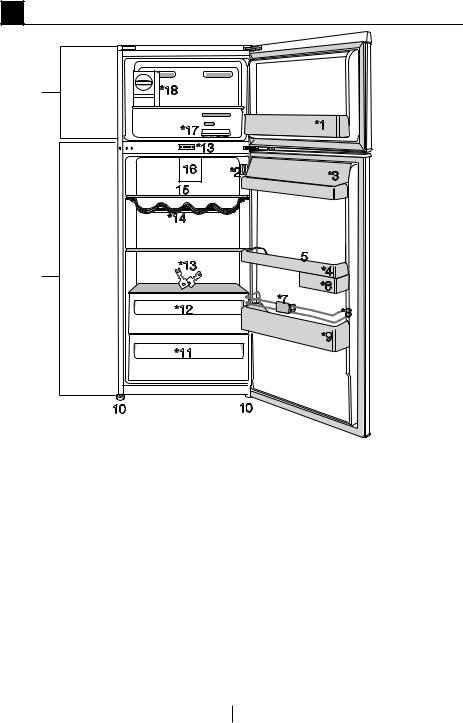
1 Su frigorífico
19 |
*18 |
|
|
|
*17 |
|
*1 |
|
|
|
|
|
*13 |
|
|
|
16 |
*2 |
*3 |
|
15 |
|
|
|
*14 |
|
|
|
*13 |
|
5 |
20 |
|
*4 |
|
|
|
||
|
|
*6 |
|
|
|
|
|
|
*12 |
|
*7 |
|
|
*8 |
|
|
|
|
*9 |
|
*11 |
|
|
10
1.Estante de la puerta del compartimento congelador
2.Botón de ajuste de la temperatura
3.Secciones de mantequillas y quesos
4.Estante de la puerta del compartimento frigorífico
5.Hueveras
6.Contenedor de almacenamiento giratorio
7.Botellero
8.Alambre protector
9.Estante para botellas
10.Patas ajustables
11.Cajón de frutas y verduras
C Las ilustraciones incluidas en el presente manual de instrucciones son esquemáticas y puede que no se adecuen a su producto con exactitud. Si alguno de los elementos reflejados no se corresponde con el producto que usted ha
adquirido, entonces será válido para otros modelos. 3 ES
